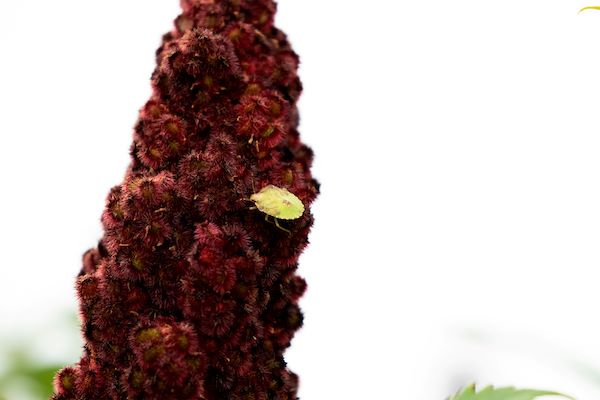
Spring snowstorms can be a challenge for everyone. For humans ready to put away shovels and snowblowers, storms can be a real annoyance. For early migrant birds looking to feed on insects, blizzards can be a real threat.
In the thick of a snowstorm in late March 2024 I witnessed a large flock of American Robins finding gustatory relief in an important but often overlooked native plant: Staghorn Sumac (Rhus typhina).
Staghorn Sumac is a member of the family Anacardiaceae, which also includes cashews, mango, Poison Ivy, and hundreds of other species. They grow in dense stands, with spindly trunks growing up to 30 feet and topped with long, fern-like leaves. Their most distinctive feature is the horn-like clusters of red berries that remain throughout the winter, providing a reliable, emergency food source when few others are available. Birds eat the berries and also pick through the clusters to find insects hidden between the berries.
Staghorn Sumac has a special place in the hearts of many at Maine Audubon. They are plentiful at several of our sanctuaries, including East Point Audubon Sanctuary and Gilsland Farm Audubon Center. In 2021, we partnered with Banded Brewing to harvest some of the edible berries from plants at Gilsland Farm to brew into a special beer, Gilsland Gose.
It also reminded me of a conversation I had with Will Broussard, a Board member at Mid-Coast Audubon, about how he cultivated Staghorn Sumac for his yard. I wrote to Will and asked him to share his story.
“For as many years as I have been birding I have noticed all sorts of avians visiting Staghorn Sumac (Rhus typhina, also known as Rhus hirta) including American Robins, Gray Catbirds, Black-capped Chickadees and even Pileated Woodpeckers. I knew that if I ever had a wildlife garden of my own I needed some sumac. Two falls ago a family friend in Bowdoinham let me dig up a few small root cuttings from a colony of sumac that was producing fruit. Note that Staghorn Sumac produces red fruit clusters while Poison Sumac and Poison Ivy produce white fruit clusters.
Staghorn Sumac is dioecious (die-EE-shus), meaning that a plant/colony is either male or female and since only females produce fruit, I knew the cuttings would also produce fruit. Indeed, after a couple of growing seasons these small cuttings produced fruit. I wanted to see if I could germinate sumac in the garden using harvested seed. Like many of our bird-dispersed plants, sumac seeds must pass through the gut of a songbird to germinate. This is known as acid scarification, and serves to weaken the hard outer seed shell prior to germination after a three-month chill period. So I removed berries from a fruit cluster and mixed them into my home-made suet (I use a mix of lard and natural peanut butter). I’ll have to report back this summer to confirm if my experiment is successful as I have only just begun putting sumac suet out for the birds. It is important to note that sumac is aggressive and will take over your garden if allowed to spread. That being said they create exceptional fall colors and if kept under control this native plant can be a welcome addition to the garden. Its flowers are pollinated in early June by native bees.”
Adding seeds to homemade suet to facilitate acid scarification is a fantastic idea to get native plants on the landscape, but it may be more than the average backyard gardener wants to take on. For others, Maine Audubon’s Native Plants Festival and Sale on June 8 will have dozens of species available for planting directly into your backyards.
While Staghorn Sumac isn’t one of the plants we sell (at least, not yet!), it remains a vital part of Maine’s native landscape and a beneficial emergency food for birds with few other options in a late-season snowstorm.
